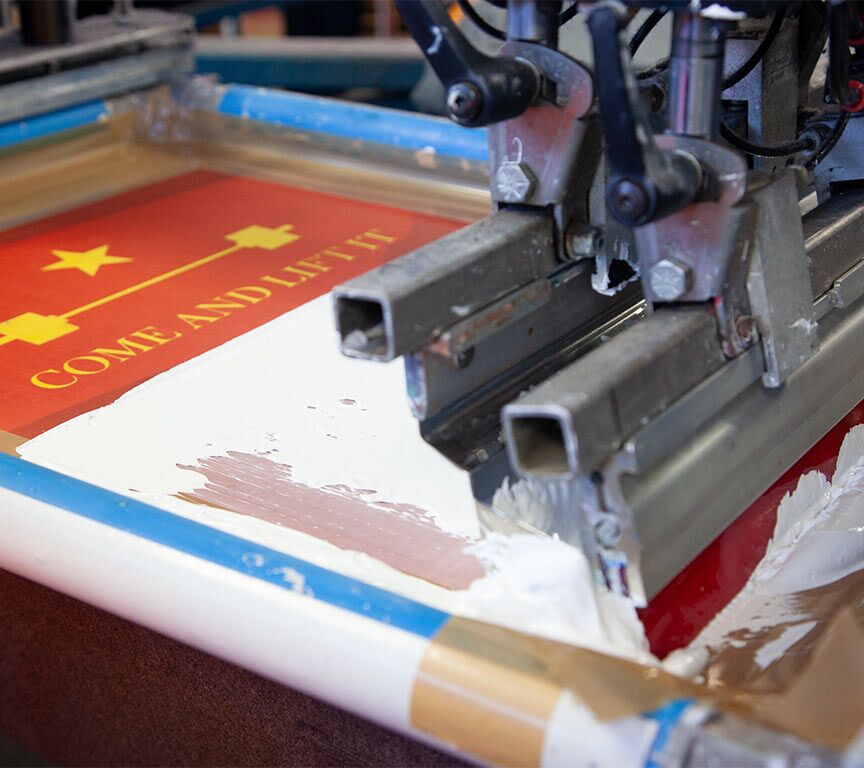Best Local T-Shirt Printing for Personalized Apparel
Best Local T-Shirt Printing for Personalized Apparel
Blog Article
Screen Printing Uncovered: Every Little Thing You Required to Know About Tee Shirt and Garment Printing Methods
Screen printing is a remarkable technique that incorporates art with method, using unlimited opportunities for creativity. Ready to discover the necessary aspects that make screen publishing an art form?
The Basics of Display Printing: How It Functions
When you plunge into display printing, you'll find it's both a scientific research and an art. At its core, screen printing involves producing a stencil, or display, that allows ink to pass with only in specific locations.
Position the display over the textile, after that use a squeegee to press ink via the screen onto the garment. Each step is necessary, and understanding them will raise your display printing abilities, transforming basic garments into special, meaningful pieces.
Sorts Of Display Printing Strategies
When you comprehend the essentials of screen printing, it's time to check out the various techniques that can boost your layouts. One preferred technique is standard screen printing, where ink is pushed via a stenciled display.
If you're going for great details, think about discharge printing. This method eliminates dye from the textile, leaving a soft, classic appearance. One more choice is plastisol printing, understood for its longevity and dazzling shades, making it a preferred for numerous brands. Ultimately, explore halftone printing to produce gradient results and complex designs. Each technique has its unique beauty, so do not be reluctant to attempt them out to find what matches your design best!
Essential Tools for Screen Printing
To achieve stunning lead to display printing, having the appropriate devices is basic. You'll need a strong display printing frame, which holds the mesh that moves your design onto the garment. Next, buy premium squeegees; these are crucial for applying ink uniformly throughout the screen. You'll likewise call for a good direct exposure unit to develop your displays, as well as a washout booth for cleaning them after usage. A reputable heat resource, like a conveyor dryer or warmth press, is essential for treating your prints to guarantee durability. Don't forget an appropriate office, geared up with tables and storage space for your supplies. Lastly, safety gear, such as gloves and masks, will certainly maintain you safe from chemicals and inks. With the right devices, you'll be well on your way to producing professional-quality prints.
Selecting the Right Inks and Products
When selecting inks and materials for screen printing, you need to think about the kind of ink that functions ideal for your task. Believe regarding material compatibility to guarantee your designs look last and terrific long. Discover eco-friendly ink options to make your printing process much more sustainable.
Kinds Of Display Inks
Choosing the ideal screen ink is important for accomplishing vibrant, resilient prints that meet your task's requirements. There are several sorts of screen inks to examine. Plastisol ink is preferred for its adaptability and ease of usage, offering excellent shade opacity on dark fabrics. Water-based ink, on the various other hand, provides a softer feeling and is green, making it optimal for those wanting to decrease their environmental influence. Discharge inks get rid of dye from the textile, resulting in a soft, classic look however call for particular handling. Ultimately, specialized inks, such as glow-in-the-dark or metal, can include distinct results to your designs. Evaluate your job requirements and choose the ink that straightens finest with your wanted outcome.

Textile Compatibility Factors To Consider
Understanding textile compatibility is essential for attaining high-quality display prints, specifically considering that different materials respond distinctly to numerous inks. When selecting inks, think about the fabric kind-- cotton, polyester, or blends. For cotton, water-based inks function well, supplying soft qualities and breathability. Polyester, on the various other hand, usually calls for plastisol inks for much better bond and lively colors. You may need to make use of a combination of both kinds if you're publishing on blends. Always test your inks on example fabric to assure they adhere correctly and keep color integrity. In addition, keep in mind that textile weight and structure can affect the last outcome, so picking the ideal ink and material combination is vital for your task's success.
Eco-Friendly Ink Options
Eco-friendly inks are ending up being a prominent selection for display printers that desire to decrease their ecological influence while keeping quality. When selecting inks, take into consideration water-based inks, which are much less unsafe and easier to clean up compared to traditional solvents.
Additionally, search for inks made from renewable energies, such as soy or vegetable-based choices. By picking the right inks and materials, you'll not just create magnificent styles but likewise add to a much more lasting printing procedure. Make the switch, and your prints will reflect your commitment to the environment!
Preparing Your Layout for Screen Printing

File Format Needs
To assure your design looks sharp and lively on fabric, you'll require to pay very close attention to file format requirements for display printing. Start with vector documents like AI or EPS, as they can be scaled without shedding top quality. If you utilize raster images, go with high-resolution documents, such as TIFF or PNG, ideally at 300 DPI. Avoid using JPEGs, as they can shed quality when resized. Also, make sure your style has a clear history to avoid unwanted white edges on your prints. Maintain shade settings in mind; CMYK is typical for display printing, so convert your RGB creates accordingly - screen printing kit. By adhering to these standards, you'll establish your art work up for a successful print.
Color Separation Methods
Color splitting up is a vital step in preparing your design for screen printing, and understanding it can greatly improve your print top quality. You'll need to break your style right into specific colors, as each shade calls for a different screen during printing. This precision not just assures precise color representation however likewise enhances the printing process.
Resolution and Size
Achieving the most effective outcomes in screen printing starts with ensuring your style has the ideal resolution and size. Ideally, your artwork ought to be at least 300 DPI (dots per inch) for sharp, clear prints. Your final product could look pixelated and amateur. if you utilize reduced resolution.
When it comes to size, think about the measurements of your print location. Layout your artwork to match the final print size, ideally developing it in the real dimensions you'll be printing. This way, you'll prevent any kind of unforeseen scaling issues.
Constantly inspect your layout in both vector and raster layouts. Vector graphics can be scaled without losing high quality, making them ideal for screen printing. Preparing properly will ensure your design looks fantastic on every garment!
Step-by-Step Screen Printing Process
Screen printing is a dynamic procedure that permits you to produce dynamic layouts on various surfaces. To get going, you'll need a screen, solution, and your chosen ink. Prepare your screen by cleaning it thoroughly. Next, apply the emulsion evenly and let it completely dry in a dark location. When dry, reveal your screen to light with your official site style positioned on it, which will harden the solution where the light hits, producing a pattern - screen printing kit.
After rinsing the unexposed emulsion, your display prepares. Establish it up on your printing surface and straighten your garment below it. Put ink onto the display and make use of a squeegee to push the ink via the pattern onto the textile. Raise the screen carefully and let the print dry. Finally, cure the ink using warm to guarantee toughness. That's it! You have actually effectively display published your design.
Tips for Successful Screen Printing Projects
While you're diving right into your display printing tasks, keep in mind that prep work is crucial to success. Start by gathering all your materials-- inks, displays, squeegees, and garments. A clean work area helps stop unwanted mistakes, so clean before you start.
Next, confirm your art work is high-resolution and effectively sized for your garment. Evaluate your display for proper direct exposure and clean it completely to avoid smudges. When blending your inks, comply with the supplier's guidelines to attain the appropriate consistency.
Throughout printing, apply even stress with your squeegee for consistent results. Do not rush; take your time to confirm each print fulfills your standards. After printing, allow your garments completely dry totally prior to dealing with or packaging them.
Last but not least, always maintain a sample of your help future referral. By doing this, you can examine your progression and improve your techniques gradually. Delighted printing!

Frequently Asked Questions
For how long Does It Require To Establish a Display Printing Work?
Establishing a display printing task usually takes about 30 mins to an hour. You'll prepare the screens, mix inks, and readjust the press. The moment varies based upon complexity and experience, so remain organized!
Can I Publish on Different Textile Keys In Utilizing the Same Technique?
Yes, you can print on various fabric kinds using the very same method, but address you'll require to change your inks and setups. Some materials absorb ink in a different way, so trying out assurances the finest results for each material.
What Are Common Mistakes to Stay Clear Of in Display Printing?
When display printing, stay clear of typical errors like utilizing the wrong ink, neglecting correct exposure times, or skipping pre-press checks. Always evaluate your arrangement and preserve clean screens to guarantee high quality results each time.
Exactly How Can I Correctly Tidy and Preserve My Display Printing Devices?
To effectively clean and maintain your display printing equipment, you must consistently wash displays with proper solvents, check mops for wear, and ensure all tools are stored completely dry and dust-free. Consistency enhances and protects against costly repair services efficiency.
Is Screen Printing Eco Friendly Contrasted to Other Approaches?
Display printing can be more eco-friendly than other techniques, especially if you make use of water-based inks and eco-conscious products. By picking sustainable supplies and techniques, you minimize waste and reduce your impact on the planet.
Display Printing Uncovered: Whatever You Required to Know About Tee Shirt and Garment Printing Techniques
At its core, display printing includes developing a pattern, or screen, that allows ink to pass with only in certain locations. Placement the display over the textile, after that use a squeegee to push ink with the display onto the garment. One preferred method is conventional display printing, where ink is pushed with a stenciled screen.When choosing inks and materials for screen printing, you require to take right into account the kind of ink that functions ideal for your task.
Report this page